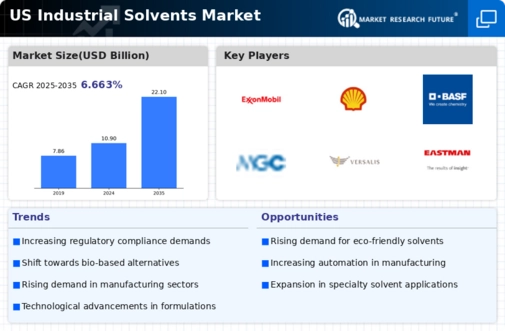The competitive landscape of the US Industrial Solvents Market is characterized by a mix of established industry players and emerging companies vying for market share. With a steady demand for solvents across various sectors, such as paints and coatings, adhesives, and pharmaceuticals, companies are increasingly focused on innovation, regulatory compliance, and sustainability. The market dynamics are shaped by factors such as fluctuating raw material prices, technological advancements in production processes, and the ongoing push for environmentally friendly alternatives to traditional solvents.
Understanding the competitive insights within this market involves assessing the strengths and weaknesses of key players, as well as their strategic initiatives aimed at maintaining a competitive edge and responding to changing consumer preferences.
ExxonMobil has a strong presence in the US Industrial Solvents Market, leveraging its extensive experience in oil and gas to offer a diverse range of solvent products tailored for industrial applications. Its strong R&D capabilities allow the company to optimize product formulations and improve the performance characteristics of its solvents, which has led to a robust portfolio that addresses various customer needs. ExxonMobil benefits from its established distribution networks and strategic partnerships that enhance its market reach and resilience.
The company's commitment to sustainability and regulatory compliance further strengthens its position in the market, as it continues to innovate in developing eco-friendly solvent alternatives. Additionally, the company's vast resources enable it to invest in advanced technologies that improve manufacturing efficiency, thus solidifying its competitive advantage.
Shell also plays a significant role in the US Industrial Solvents Market, focusing on a range of high-performance solvents that cater to diverse industries such as coatings, pharmaceuticals, and cleaning products. Shell's strength lies in its innovative product offerings, including specialty solvents designed for specific applications, which set it apart from competitors. The company's commitment to sustainability is evident in its investment in biobased solvents and processes that minimize environmental impact. Shell has enhanced its market presence through strategic mergers and acquisitions, allowing it to integrate new technologies and expand its product line.
Its extensive network of distribution channels ensures the efficient delivery of solvents across the US market. As a result, Shell's emphasis on innovation, sustainability, and strategic growth initiatives significantly contributes to its competitive positioning within the US Industrial Solvents Market.



















